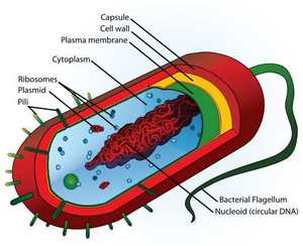Structure and Growth

Borrelia burgdorferi is a highly specialized, two-membrane, flat-waved spirochete, ranging from about 9 to 32 micrometers in length. The bacterial membranes in the B31, NL303 and N40 strains of B. burgdorferi do not contain lipopolysaccharide, but contain glycolipids. However, the B31 strain contains a lipopolysaccharide-like substance. B. burgdorferi requires little oxygen to survive and lives as an extracellular pathogen, except when it transmits in vitro, where it then hides in the cell.
The external membrane of B. burgdorferi is 46% protein, 51% lipid and 3% carbohydrate. Borrelia burgdorferi is a distinct bacteria that moves through the use of axial filaments (endoflagella) that are contained within the periplasmic space between a semi rigid peptidoglycan helix and a multi-layer, flexible outer membrane sheath. When the filaments rotate within this space, the spirochetes move in cork-screw fashion. For pathogens, this allows the spirochetes to hide their flagella, which are normally antigenic, from the host immune defenses.
Borrelia burgdorferi grows slowly and doubles in 12–18 hours. As a result, patients with Lyme disease must participate in longer treatment courses. B. burgdorferi can be cultivated in vitro. However, the bacterium is very concerned about accuracy and detail and requires a very complex growth medium. The medium used to grow Borrelia burgdorferi is called the Barbour-Stoenner-Kelly (BSK) medium. It has more than thirteen ingredients in a rabbit serum base. B. burgdorferi has a favorable temperature for growth of 32 degrees Celsius, but growth time is still slow. Borrelia burgdorferi from ticks and from the blood, skin, and cerebrospinal fluid of Lyme disease patients has been successfully cultivated in BSK medium, producing colonies from single organisms.
The external membrane of B. burgdorferi is 46% protein, 51% lipid and 3% carbohydrate. Borrelia burgdorferi is a distinct bacteria that moves through the use of axial filaments (endoflagella) that are contained within the periplasmic space between a semi rigid peptidoglycan helix and a multi-layer, flexible outer membrane sheath. When the filaments rotate within this space, the spirochetes move in cork-screw fashion. For pathogens, this allows the spirochetes to hide their flagella, which are normally antigenic, from the host immune defenses.
Borrelia burgdorferi grows slowly and doubles in 12–18 hours. As a result, patients with Lyme disease must participate in longer treatment courses. B. burgdorferi can be cultivated in vitro. However, the bacterium is very concerned about accuracy and detail and requires a very complex growth medium. The medium used to grow Borrelia burgdorferi is called the Barbour-Stoenner-Kelly (BSK) medium. It has more than thirteen ingredients in a rabbit serum base. B. burgdorferi has a favorable temperature for growth of 32 degrees Celsius, but growth time is still slow. Borrelia burgdorferi from ticks and from the blood, skin, and cerebrospinal fluid of Lyme disease patients has been successfully cultivated in BSK medium, producing colonies from single organisms.
